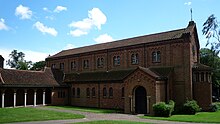Bournville
Historically in northern Worcestershire, it is also a ward within the council constituency of Selly Oak and home to the Bournville Centre for Visual Arts and the Cadbury's chocolate factory.
[5] Originally the area that was to become Bournville consisted of a few scattered farmsteads and cottages, linked by winding country lanes, with the only visual highlight being Bournbrook Hall, which was built during the Georgian era.
The bluebell glades of Stock Wood were said to be a relic of the Forest of Arden and there are Roman remains nearby.
In 1893, George Cadbury bought 120 acres (0.5 km2) of land close to the works and planned, at his own expense, a model village which would "alleviate the evils of modern, more cramped living conditions".
By 1900, the estate included 313 cottages and houses set on 330 acres (1.3 km2) of land, and many more similar properties were built in the years leading up to the First World War, with smaller developments taking place later on in the 20th century.
It is also noteworthy that, because George Cadbury was a temperance Quaker, no public houses have ever been built in Bournville;[7] however, since the late 1940s, there has been a licensed members' bar at Rowheath Pavilion.
The Cadburys were particularly concerned with the health and fitness of their British workforce, incorporating park and recreation areas into the Bournville village plans and encouraging swimming, walking and indeed all forms of outdoor sports.
[8] In the early 1920s, extensive open lands were purchased at Rowheath and laid to football and hockey pitches together with a grassed running track.
Rowheath Pavilion was designed and built in accordance with the instructions of George Cadbury and opened in July 1924.
The lido was eventually closed in the 1970s after complaints of noise disturbance were made by residents of the newly built Oak Farm estate, coupled with new and stringent health and safety regulations relating to outdoor public swimming facilities.
Cadbury's also built the Bournville indoor swimming baths on Bournville Lane (separate buildings for 'girls' and men), the Valley pool boating lake and the picturesque cricket pitch adjacent to the factory site, that was made famous as the picture on boxes of Milk Tray chocolates throughout the 1950s and early 1960s.
[9] The trust focused on providing schools, hospitals, museums, public baths and reading rooms.
Bournville has adopted a Ward Support Officer with the current holder of the title being Karen Stevens.
[12] The college relocated to a new campus in Longbridge in September 2011 at a cost of £66 million kick-starting wider regeneration of the area after the collapse of carmaker MG Rover in 2005.
Bournville lies on the A4040, the ring road developed in the 1920s and served by the 11A and 11C Birmingham Outer Circle bus routes.
The National Cycle Network route five passes near Bournville (map) towards Hurst Street in the City Centre.
The Worcester and Birmingham Canal towpath can be joined at the railway station and serves as a de facto cycle route to Brindleyplace.
In addition to a site in Moseley, Riverside Church[17] also meets in Bournville, at Dame Elizabeth Cadbury School.
The church is built in the traditional Byzantine style of the Balkans and is consciously modelled on some famous examples.
Being intended also to serve other Christian denominations, it was equipped with an organ, which would not normally be expected in a Quaker meeting house in Britain.
The Bournville Friends Meeting House is located on Linden Road, and features a bust of George Cadbury by Francis Wood, installed in 1924.
[19] As a part of this Quaker tradition, Bournville is a dry town with no alcohol permitted to be sold within the historic estate boundaries.



